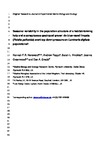Seasonal variability in the population structure of a habitat-forming kelp and a conspicuous gastropod grazer: Do blue-rayed limpets (Patella pellucida) exert top-down pressure on Laminaria digitata populations?
| dc.contributor.author | Hereward, H | |
| dc.contributor.author | Foggo, A | |
| dc.contributor.author | Hinckley, S | |
| dc.contributor.author | Greenwood, J | |
| dc.contributor.author | Smale, D | |
| dc.date.accessioned | 2018-07-18T14:32:55Z | |
| dc.date.issued | 2018-09 | |
| dc.identifier.issn | 0022-0981 | |
| dc.identifier.issn | 1879-1697 | |
| dc.identifier.uri | http://hdl.handle.net/10026.1/11850 | |
| dc.description.abstract |
Kelp forests dominate wave-exposed rocky reefs along mid-to-high latitude coastlines. The distribution and structure of kelp forests is determined by a range of physical and biological processes operating across varying spatial and temporal scales. Many kelp forest systems are strongly influenced by herbivory, and overgrazing by urchins, in particular, is a recognised driver of kelp forest distribution and structure. The ecological significance of herbivory by kelp-associated limpets, however, has received far less attention. We quantified seasonal population dynamics of Laminaria digitata and the blue-rayed limpet Patella pellucida on two rocky shores in North Devon, UK. For the kelp, we quantified density, percent cover, morphology, standing biomass, elongation and erosion rates, and C:N and phenol content. For the limpet, we measured abundance, biomass, and morphology, and for the limpet-kelp interaction we recorded observable grazing damage on the blade. Both populations exhibited typical seasonality with kelp growth rates peaking in spring, maximum standing biomass observed in summer and increased erosion rates in autumn. Blue-rayed limpets, which were recorded within kelp holdfasts as well as on stipes and blades, recruited in spring and peaked in abundance in late summer, with length and biomass generally increasing through the year. The area of kelp blade damaged by limpet grazing was low (a maximum of ~4%) and relatively consistent throughout the year, and the number and size of grazing scars exhibited limited seasonality. Survey data from other L. digitata populations in the UK suggested that the limpet abundances recorded in North Devon were comparable with other sites in the region. Although the impact of P. pellucida grazing on kelp blade tissue appears to be minimal, further research into cavity grazing by limpets on the stipe and in the holdfast is needed to formerly assess the impact these cavities have on dislodgement and fracture rates, especially when increased occupancy and grazing coincides with periods of intense wave action. We conclude that while herbivory is an important processes acting upon many kelp populations globally, the grazing pressure exerted by P. pellucida on L. digitata is unlikely to strongly influence population structure on UK rocky shores. | |
| dc.format.extent | 171-171 | |
| dc.language | en | |
| dc.language.iso | en | |
| dc.publisher | Elsevier | |
| dc.subject | Temperate reefs | |
| dc.subject | Northeast Atlantic | |
| dc.subject | Macroalgal beds | |
| dc.subject | Laminariales | |
| dc.subject | Grazers | |
| dc.subject | Herbivory | |
| dc.title | Seasonal variability in the population structure of a habitat-forming kelp and a conspicuous gastropod grazer: Do blue-rayed limpets (Patella pellucida) exert top-down pressure on Laminaria digitata populations? | |
| dc.type | journal-article | |
| dc.type | Article | |
| plymouth.author-url | https://www.webofscience.com/api/gateway?GWVersion=2&SrcApp=PARTNER_APP&SrcAuth=LinksAMR&KeyUT=WOS:000440960500020&DestLinkType=FullRecord&DestApp=ALL_WOS&UsrCustomerID=11bb513d99f797142bcfeffcc58ea008 | |
| plymouth.volume | 506 | |
| plymouth.publication-status | Published | |
| plymouth.journal | Journal of Experimental Marine Biology and Ecology | |
| dc.identifier.doi | 10.1016/j.jembe.2018.06.011 | |
| plymouth.organisational-group | /Plymouth | |
| plymouth.organisational-group | /Plymouth/Faculty of Science and Engineering | |
| plymouth.organisational-group | /Plymouth/Faculty of Science and Engineering/School of Biological and Marine Sciences | |
| plymouth.organisational-group | /Plymouth/REF 2021 Researchers by UoA | |
| plymouth.organisational-group | /Plymouth/REF 2021 Researchers by UoA/UoA07 Earth Systems and Environmental Sciences | |
| plymouth.organisational-group | /Plymouth/Research Groups | |
| plymouth.organisational-group | /Plymouth/Research Groups/Marine Institute | |
| plymouth.organisational-group | /Plymouth/Users by role | |
| plymouth.organisational-group | /Plymouth/Users by role/Academics | |
| dcterms.dateAccepted | 2018-06-28 | |
| dc.rights.embargodate | 2019-7-6 | |
| dc.identifier.eissn | 1879-1697 | |
| dc.rights.embargoperiod | Not known | |
| rioxxterms.versionofrecord | 10.1016/j.jembe.2018.06.011 | |
| rioxxterms.licenseref.uri | http://www.rioxx.net/licenses/all-rights-reserved | |
| rioxxterms.licenseref.startdate | 2018-09 | |
| rioxxterms.type | Journal Article/Review |


